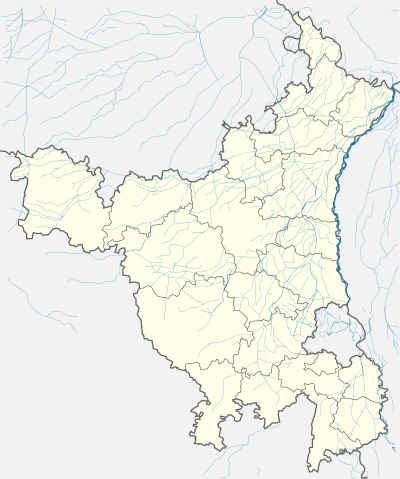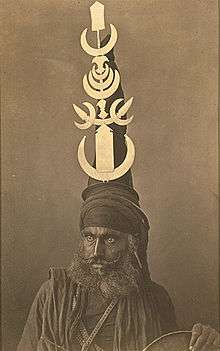Lohgarh (Bilaspur)
| Lohgarh | |
|---|---|
| village | |
 Lohgarh  Lohgarh Location in Haryana, India | |
| Coordinates: 30°25′43.38″N 77°24′25.11″E / 30.4287167°N 77.4069750°ECoordinates: 30°25′43.38″N 77°24′25.11″E / 30.4287167°N 77.4069750°E | |
| Country | India |
| State | Haryana |
| District | Yamunanagar district |
| Tehsil | Bilaspur |
| Population | |
| • Total | m |
| ISO 3166 code | IN-HR |
| Website |
haryana |
Lohgarh (Hindi: लोहगढ़) is a historic town in Bilaspur tehsil of Yamunanagar district of Haryana in India. It was the capital of the first Sikh state under Banda Singh Bahadur from 1710 to 1715.[1]
Location
It is situated on an elevated summit at the steps of Himalayas, about half way between Nahan in Himachal Pradesh and Sadaura in Haryana about 21 miles [2] from Sadaura, it could be approached only by curly rocks and ravines.
From Chandigarh to Raipur Rani, Sadhaura, Bilaspur, Haryana, Kapal Mochan, Lohgarh Sahib. From other parts of Haryana of Uttar pradesh, proceed to Sadhaura.
History
Salim Shah Suri, also known as Islam Shah Suri was the son of Sher Shah Suri. He had constructed a small fort called Pawangarh. Later on, Mukhlis Khan, an emir of Shah Jahan who had waged Battle of Amritsar (1634) against Guru Hargobind and the Sikhs in 1634, used this for his summer resort. His son Mohammad Yarbeg Khan was killed by Guru Har Rai.
After capturing Sirhind, in 1709 Banda Singh Bahadur captured Sadaura in 1709. He made Mukhlispur [3] the capital of first Sikh Empire, established where Mukhlisgarh fort had been built by Shah Jahan. Old fort was repaired by Banda Singh, he fortified it further & given a new name Lohgarh or Iron fort. It was surrounded by two rivulets Pamuwali and Daskawali, originally forming one stream.[2]
He established the Khalsa Raj. He punished Usman Khan. He punished Wazir Khan. The entire treasury acquired in his expeditions was deposited here in Lohgarh Sahib. The coins in the name of Guru Nanak and Guru Gobind Singh were minted and issued from here. He was brave in battles. He was brave when executed in Delhi.
Khalsa Currency & Stamp
Banda Singh Bahadur issued Khalsa currency from here, a coin in the name of Guru Nanak-Gobind Singh with Persian inscription sikkah bar har do alam tegh-i-Nanak wahib ast, Fateh Gobind Singh shah-i-shahan Fazal-i-Sacha Sahib ast (Coin struck in the two Worlds by the grace of True Lord; Victory to Gobind Singh, the King of Kings; the sword of Nanak is granter of desires). Banda singh also had a royal stamp inscribed, Degh Tegh Fateh Nusrait-i-Bedirang Yaft az Nanak Guru Gobind Singh (The kettle (symbol to feed the poor), the sword ( symbol of power to protect the weak and helpless) the Victory and unhesitating patronage has been obtained from Nanak Guru Gobind Singh).[4]
After Banda Singh Bahadur left Lohgarh in 1715 in search of a more secure place to defend against attacking Mughal forces, the Mughal and the forces of the Nahan State repeatedly uprooted the fort at Lohgarh. Presently there are only ruins of the fort in form of a few stones.[5]
Lohgarh Sahib Fort
Lohgarh Sahib Fort is short climb away on a hill near Lohgarh village, the hill top has two Nishan Sahib, saffron and blue, surrounded by the ruins of the fort. Th fort has including four watch towers on four different hillocks each one of which has a Nishan Sahib. The Lohgarh village, gurudwara Lohgarh sahib and Loghgarh Sahib Fort are in Haryana and parts of ramparts of Loghgarh Sahib Fort are in Himachal Pradesh.[5]
Battle of Lohgargh
Near the fort is a trench. Mughal King Bahadur Shah I himself led the army to Sadaura and sent his army to besiege the fort of Lohgarh Sahib. Khalsa army men fought here for one month under Baba Banda Singh. The fort was destroyed by the Mughal artillery, Banda Singh had a narrow escape and could not be captured alive. At last they disappeared towards upper hills of Nahan through this treanch. Mogul army could not find them.[5]
Lohgarh Sahib Gurudwara

Lohgarh Sahib Gurudwara is a small historic Gurudwara in Lohgarh, built during the times of Banda Singh Bahadur, it is now managed by the Nihangs of Budhha Dal (nihang warriors over the age of 40) who are eager to welcome all visitors and show around the gurudwara and fort.[5] Sikh miltias during the Sikh empire over 40 years of age were part of the Budda Dal and Sikh militas under 40 years were part of the Taruna Dal.[6]
The Nihang (Punjabi: ਨਿਹੰਗ) are an armed Sikh order.[7] They are also referred to as Akali (lit. "the immortals"). Early Sikh military history was dominated by the Nihang, known for their victories where they were heavily outnumbered. Traditionally known for their bravery and ruthlessness in the battlefield, the Nihang once formed the guerrilla squads of the armed forces of Ranjit Singh.
Banda Singh Bahadur statue
Banda Singh Bahadur statue is installed by the Sikh sangat at gurudwara Lohgarh Sahib during tercentinary celebrations.
Infrastructure Development
The Government of Haryana is developing Lohgarh as tourist destination. The development activities undertaken by the government of Haryana incile a 3 km road connecting Lohgarh to Adi Badri (Haryana) which is the point of origin of Sarasvati river, a two km long road and bridge on Somb river to connect Bhagwanpur village with Lohgarh, construction of a dam to ensure year-round supply of water to Lohgarh and a memorial of the brave warrior Banda Singh Bahadur built at Lohgarh on the similar grandeur as of the one at Chappar Chiri in Punjab.[8]
See also
- Panoramio photo of Gurudwara Quila Lohgarh only left mark of first Sikh state set up by Banda Singh Bahadur
- Adi Badri (Haryana)
- Sarasvati river
- Sadaura
- Kaushalya Dam
- Morni
external reference
- Banda Singh wins Sadhura
- Dasam Granth ,The Dasam Granth website
- Book review of the Nihang book The Beloved Forces of the Guru
- "Tribes and Castes of Punjab and N.W. Frontier Province" by H.A. Rose (1892)
- Bhai Sahib Amrit Pal Singh 'Amrit' has presented well-researched articles on Nihangs on his website
- www.Budhadal.com
- www.lohgarh.com
References
- ↑ singh, Dr. Ganda (1964). Banda Singh Bahadur(in Punjabi. Sikh Itihaas Research Board, SGPC , AMRITSAR.
- 1 2 Singh, Ganda (1935). Life of Banda Singh Bahadur. Sikh History Research Department, Khalsa College, Amritsar. p. 82.
- ↑ Bingham,Jane "Sikhism" p. 21 Small Apple Media
- ↑ Giani, Seetal Singh. The Rise of Sikh Power. Lahore Book Shop.
- 1 2 3 4 visit to Lohgarh sahib
- ↑ Singha, H. S. (2005). Sikh Studies, Book 6. Hemkunt Press. p. 37. ISBN 8170102588.
- ↑ Brard, Gurnam (2007). East of Indus: My Memories of Old Punjab. Hemkunt Press. p. 185. ISBN 9788170103608.
- ↑ Haryana Govt to develop Lohgarh in tourist spot
